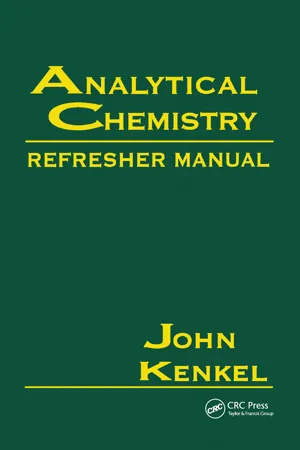Chemistry
Dilution
Dilution refers to the process of reducing the concentration of a solution by adding more solvent. This is typically done to decrease the strength or intensity of a solution, making it less concentrated. It is commonly achieved by adding more solvent to the original solution, resulting in a larger volume with a reduced concentration of the solute.
Written by Perlego with AI-assistance
Related key terms
Related key terms
1 of 4
Related key terms
1 of 3
6 Key excerpts on "Dilution"
- eBook - ePub
- Wayne R. Ott(Author)
- 2018(Publication Date)
- CRC Press(Publisher)
8 Dilution of Pollutants Polluters discharge chemicals into the environment to dispose of them. Environmental pollution becomes a problem to society because such chemicals sometimes do not disappear. In some cases, such as the pesticide DDT, they are sufficiently inert, or persistent, to remain in the environment for many years. However, discharging a chemical into the environment usually reduces its adverse effects by reducing its concentration (quantity of chemical per unit volume). Concentration reduction is achieved whenever a particular quantity of a chemical (the pollutant) mixes with some other material (the carrier medium), thereby becoming diluted. Dilution is the process by which the molecules of a substance become distributed over a larger physical volume than they formerly occupied. Dilution always accompanies the formal process of diffusion (Chapter 6), because the molecules in a diffusion process tend to spread out and occupy an ever-increasing volume. However, Dilution also can occur in processes that do not primarily involve diffusion, such as the simple mechanical mixing of one chemical liquid with another. For example, if two chemically unreactive liquids are combined together in one container and shaken until they are uniformly mixed, the volume of the resulting mixture will be the sum of the volumes of the two original constituents, and each original constituent will become diluted. Dilution occurs in a large number of common everyday examples: introduction of syrup flavoring when one prepares a milkshake; addition of pigments to raw base paint to give it color; insertion of drops of medicine into a glass of water. Dilution also occurs when concentrated soap is added to a bucket of water for scrubbing the floor. It occurs when table salt is dissolved in hot water prior to cooking rice - eBook - ePub
Calculations for Molecular Biology and Biotechnology
A Guide to Mathematics in the Laboratory
- Frank H. Stephenson(Author)
- 2010(Publication Date)
- Academic Press(Publisher)
Whether it is an organism or an enzyme, most biological activities function optimally only within a narrow range of environmental conditions. From growing cells in culture to sequencing of a cloned DNA fragment or assaying an enzyme’s activity, the success or failure of an experiment can hinge on paying careful attention to a reaction’s components. This section outlines the mathematics involved in making solutions.2.1 Calculating Dilutions – A General Approach
Concentration is defined as an amount of some substance per a set volume:Most laboratories have found it convenient to prepare concentrated stock solutions of commonly used reagents, those found as components in a large variety of buffers or reaction mixes. Such stock solutions may include 1 M (mole)Tris, pH 8.0, 500 mM ethylenediaminetetraacetic acid (EDTA), 20% sodium dodecylsulfate (SDS), 1 M MgCl2, and any number of others. A specific volume of a stock solution at a particular concentration can be added to a buffer or reagent mixture so that it contains that component at some concentration less than that in the stock. For example, a stock solution of 95% ethanol can be used to prepare a solution of 70% ethanol. Since a higher percent solution (more concentrated) is being used to prepare a lower percent (less concentrated) solution, a Dilution of the stock solution is being performed.There are several methods that can be used to calculate the concentration of a diluted reagent. No one approach is necessarily more valid than another. Typically, the method chosen by an individual has more to do with how his or her brain approaches mathematical problems than with the legitimacy of the procedure. One approach is to use the equation C 1 V 1 = C 2 V 2 , where C 1 is the initial concentration of the stock solution, V 1 is the amount of stock solution taken to perform the Dilution, C 2 is the concentration of the diluted sample, and V 2 is the final, total volume of the diluted sample.For example, if you were asked how many μL of 20% sugar should be used to make 2 mL of 5% sucrose, the C 1 V 1 = C 2 V 2 - eBook - ePub
- John Kenkel(Author)
- 2020(Publication Date)
- CRC Press(Publisher)
Chapter 2 for a description of the volumetric flask and its use.) However, if the solution concentration need not be known accurately, then any balance, or any type of liquid transfer glassware if the solute is already in solution, would work, and a volumetric flask need not be used.With these thoughts in mind, we proceed with a series of discussions giving specific instructions as to calculations and methods used in a variety of situations involving various concentration units.3.2 Dilution
One method of preparing solutions, as alluded to in the last section, is by Dilution, i.e., the solute is already in solution, but a lower concentration of it is called for. Regardless of the units with which the concentration (or volume) is expressed, the general calculation and method of preparation is the same. The calculation uses the following formula:C B×V B=C A×V A(3.1) in which “C” refers to “concentration,” “V” is “volume,” “B” refers to “before Dilution,” and “A” to “after Dilution.” The concentration of the solution before Dilution times its volume is equal to the concentration of the solution after Dilution times its volume. The concentrations before and after Dilution must be known, and the volume after Dilution must be known. The volume before Dilution is being calculated in order to know how much of the more concentrated solution to measure out and dilute. The units of concentration must be the same on both sides of the equation (e.g., percent, molarity, normality, etc.). The units of volume are also the same on both sides. - Robert Bill(Author)
- 2018(Publication Date)
- Wiley-Blackwell(Publisher)
diluted solution. The ratio of this Dilution to original solute would be represented as:A 1 : 10 liquid Dilution is also called a 1 : 10 volume‐to‐volume Dilution because it is made up of 1 part original liquid solute (such as a liquid form of a drug) mixed with 9 parts of a liquid solvent/diluent (such as IV fluid or saline solution) to produce a total of 10 parts of diluted solution. A 1 : 10 Dilution is shown graphically in Figure 10.1 . A 1 : 10 Dilution of the original solute means the solute will be diluted to 1/10th of its original strength. For example, if 1 mL of the original liquid solute containing 80 mg (i.e. drug concentration is 80 mg/mL) is mixed with 9 mL of a solvent/diluent such as water, 80 mg of drug is now dissolved in a larger 10 mL of the final diluted solution. The concentration of the diluted solution is 80 mg of drug in 10 mL of fluid and can be represented as the ratio fraction 80 mg/10 mL. 80 mg/10 mL reduces to 8 mg/mL, reflecting a 1/10th Dilution of the original 80 mg/mL concentration.Figure 10.1The hardest part for most students when they first begin working with Dilutions is that they think of ratios such as “1 : 10” as being 1 part original solute with 10 parts of the solvent/diluent. No! The larger part of the ratio (e.g. the 10 in the 1 : 10 ratio) always refers to the total volume of the final diluted solution, not to the parts of the solvent diluent.Ratios for Dilution don't necessarily have to be “one to something” but can be 5 : 15, 2 : 10, 4 : 25, etc. For a 5 : 15 ratio Dilution, the original solute would be 5 parts and the final diluted solution would be 15 parts. To determine the amount of solvent/diluent that must be added to the original solute to make the diluted solution, the parts of the original solute (5) would be subtracted from total number of parts of the total diluted solution (15). 15 minus 5 equals 10 parts of solvent/diluent needed. If each “part” in the previous example was 1 mL (e.g. 5 parts equals 5 mL) then the actual volume of solvent/diluent added to the original solute would have been 10 mL. Knowing the parts of the solute, the parts of the final diluted solution, and determining the parts of the solvent/diluent will be a recurring calculation used for all Dilution problems.- Frank H. Stephenson(Author)
- 2016(Publication Date)
- Academic Press(Publisher)
Chapter 2Solutions, Mixtures, and Media
Abstract
Whether it is an organism or an enzyme, most biological activities function at their optimum only within a narrow range of environmental conditions. From growing cells in culture to sequencing of a cloned DNA fragment or assaying an enzyme's activity, the success or failure of an experiment can hinge on paying careful attention to a reaction's components. This section outlines the mathematics involved in making solutions. This chapter covers how to make Dilutions to new concentrations of percent, molarity, factor of X, and normality. This chapter shows how to calculate pH and how the Henderson–Hasselbalch equation is used to prepare a buffer having a particular desired pH.Keywords
Acid; Acid dissociation constant; Addition property of equality; Base; Bronsted acid; Bronsted base; Conjugate acid; Conjugate base; Dilution; Dimensional analysis; Equilibrium; Formula weight; Gram molecular weight; Henderson–Hasselbalch equation; Molarity; Molecular weight; Multiplication property of equality; Normality; Percent; pHIntroduction
Whether it is an organism or an enzyme, most biological activities function at their optimum only within a narrow range of environmental conditions. From growing cells in culture to sequencing of a cloned DNA fragment or assaying an enzyme's activity, the success or failure of an experiment can hinge on paying careful attention to a reaction's components. This section outlines the mathematics involved in making solutions.2.1. Calculating Dilutions: A General Approach
Concentration is defined as an amount of some substance per a set volume:concentration =amount volumeMost laboratories have found it convenient to prepare concentrated stock solutions of commonly used reagents, those found as components in a large variety of buffers or reaction mixes. Such stock solutions may include 1 M Tris, pH 8.0, 500 mM EDTA, 20% sodium dodecylsulfate (SDS), 1 M MgCl2 , and any number of others. A specific volume of a stock solution at a particular concentration can be added to a buffer or a reagent mixture so that it contains that component at some concentration less than that in the stock. For example, a stock solution of 95% ethanol can be used to prepare a solution of 70% ethanol. Since a higher percent solution (more concentrated) is being used to prepare a lower percent (less concentrated) solution, a Dilution- eBook - ePub
- Enrico Fermi(Author)
- 2012(Publication Date)
- Dover Publications(Publisher)
CHAPTER VIIThe Thermodynamics of Dilute Solutions
25. Dilute solutions.
A solution is said to be dilute when the amount of solute is small compared to the amount of solvent. In this section we shall develop the fundamental principles of the thermodynamics of dilute solutions.Let us consider a solution composed of N 0 moles of solvent and N 1 , N 2 , ··· , N g moles of the several dissolved substances A 1 , A 2 , ··· , A g , respectively. If our solution is very dilute, we must have:(145)Our first problem will be to find the expressions for the energy, the volume, the entropy, and so forth, of our dilute solution. A straightforward application of the thermodynamic equations will then yield all the other properties of the dilute solution.We consider first the energy U of our solution. Let u be the energy of a fraction of the solution containing one mole of solvent. This fraction of the solution will contain N 1 /N 0 moles of the solute A 1 , N 2 /N 0 moles of the solute A 2 , ··· , N g /N 0 moles of the solute A g . Its energy will be a function of T , p , and the quantities N 1 /N 0 , N 2 /N 0 , ··· ,N g /N 0 ; that is,(146)Since the entire solution contains N 0 moles of solvent, its energy U is N 0 times larger than (146); that is,(147)We now make use of the fact that, since our solution is dilute, the ratios N 1 /N 0 , N 2 /N 0 , ··· , N g /N 0 are very small. We assume, therefore, that it is possible to develop the function (146) in powers of these ratios and to neglect all powers above the first. If we do this, we obtain:Substituting this expression in (147), we find that:(148)It should be noted that although the various terms in the expression (148) for U are formally quite similar, the first term is much larger than all the others because of the inequalities (145).By a similar process of reasoning, we can show that, to the same order of approximation, the volume can be written as:(149)We must now obtain the expression for the entropy of our solution. To do this, we consider an infinitesimal reversible transformation during which T and p change by the infinitesimal amounts dT and dp, while the quantities N 0 , N 1 , ··· , N g
Index pages curate the most relevant extracts from our library of academic textbooks. They’ve been created using an in-house natural language model (NLM), each adding context and meaning to key research topics.
Explore more topic indexes
Explore more topic indexes
1 of 6
Explore more topic indexes
1 of 4





